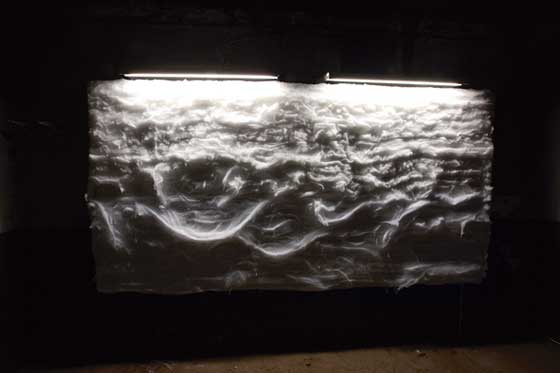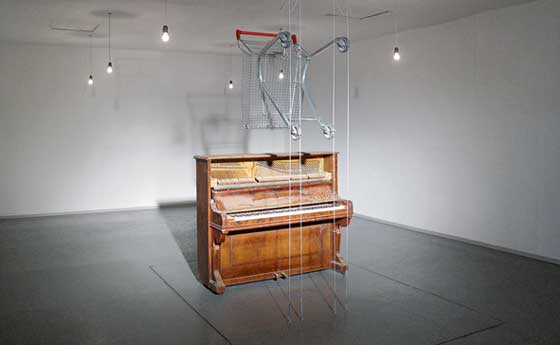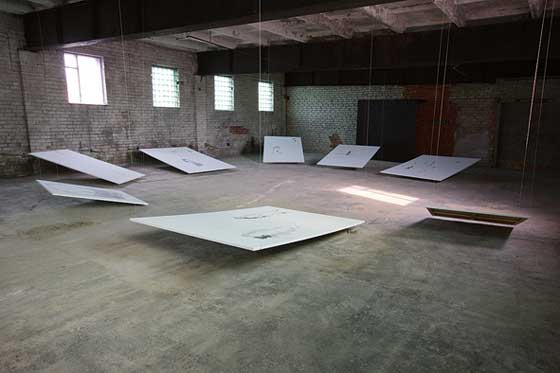|
|
| A curator’s luck Alise Tīfentāle, Art Historian Cesis Art Festival 2010 23.07.–15.08.2010. Cēsis Old Brewery | |
| I guess it’s interesting to try to be another sex, but it can be exciting to just be your own sex(1). (Andy Warhol) Keeping in mind the difference between luck and achievement, the achievement of art curator Daiga Rudzāte is a superior quality exhibition of Baltic artists at the Cesis Art Festival. But group exhibitions are made not just by putting together the works of artists. They are also influenced by the will and authority of the curator, as well as the luck of the curator – a coincidence of facts which, if skilfully put to use, allows the works displayed and even more extensive connections to be seen in a completely new light. This kind of luck can at times also mean not only proactive participation, but also not interfering and not permitting changes. This year the fortunate choice of curator Daiga Rudzāte was to leave the office on the first floor of the former beer brewery untouched and unimproved. Viewers had to pass through this space to enter the spacious hall where the exhibition of Anda Lāce’s paintings can be seen, adjoined by a smaller space displaying photographs by Valts Kleins. Taking into account the overall emphasis of the exhibition on visuality(2), this office space broke into the monologue of the exposition with its own retort of authentic conceptualism in the spirit of Ilya and Emil Kabakov. Although the designer of the office remains anonymous, the space was consciously “left as it was”, and this added new and unexpected dimensions, some maybe unforeseen by the curator, to the art exhibition. The contemporary and the current could be viewed at the same time, side by side with vestiges of history and uneasy forecasts for the future. Alongside flashes of contemporary art, the collective and individual historic experience stood in all its glory, inevitable and just as predestined as a person’s birth date. The viewer’s attention was captured not only by the creativity of the artists, but also by the role of the curator as a knowledgeable guardian who nurtures art and artists. | |
 Kristaps Ģelzis. Without Words. Installation. 2010. Photo: Martins Vizbulis | |
| The aspect of sustainability and the contemporary Sustainability is one of those words which began to be intensively used in Latvia after its accession to the European Union. Sustainability always needs to be kept in mind when applying for co-financing from international institutions or seeking support for various projects, and, like it or not, the mind starts to apply this categorisation to the most diverse areas of life, including art. Is sustainability compatible with the contemporary? In response to a questionnaire by the magazine October, Mark Godfrey, curator of Tate Modern, points out: “What’s new therefore is not a lack of definition and determination so much as a different relationship between art and the present and indeed between art and time and history more broadly.”(3) Julia Bryan-Wilson, Associate Professor of Art History at the University of California, speaks about the contemporary in its connection to the notion of time and its partially metaphysical sustainability.(4) Bryan-Wilson tells us about a toxic radioactive waste dump site in the desert which stores substances with radio-activity so lethal that its hazardousness will not disappear for another 10,000 years. Scientists decided to install sustainable markers at these locations, which would warn future generations about the hazards. The Department of Energy of the USA had commissioned granite obelisks which would have a sign inscribed in seven languages: “Danger. Poisonous radioactive waste buried here. Do not dig or drill here until 12,000 A.D.”(5) The art historian’s professional interest was aroused by the fact that the scientists had not asked any experts of visual art to contribute to this project, and yet they were not able to do without visual signs. One of the images used on the granite markers is apparently a schematic outline of Edvard Munch’s The Scream, to symbolically convey the danger of the place forever and ever. Musing over this choice of visual material Bryan-Wilson points out that “in the past one hundred years alone, Munch’s image has generated conflicting readings and undergone significant semantic transformations – who knows how it might read thousands of years from now?”(6) In cases like these, the familiar is unexpectedly turned upside down and we are made to look simultaneously at the past and into the unforeseeable future. The notion of the contemporary, as well as contemporary art, does not include the aspect of quality, it does not possess a dimension of ethics or taste. It is possible to discuss contemporary works of art, but without hasty conclusions. A distinctly contemporary phenomenon also was, for example, the duet of Russian pop music king Philip Kirkorov and the opera diva Anna Netrebko during the guest concert at the international contest of young performers ‘New Wave 2010’ in Jūrmala. Should we draw any conclusions from it? | |
 Andris Breže. The Stations of Desire. Installation. 2010. Photo: Līga Marcinkeviča | |
| The Baltic version of Altermodern In parallel with the actual artworks themselves, the visual arts exhibition at the Cesis Art Festival had two important factors vying for the viewers’ attention: the exhibition space (the former beer brewery) and the name of the exhibition Take Care(7), which was derived from an appeal by the German art curator Norbert Weber to take care of the existing world.(8) Since the first Cesis Art Festival in 2007(9), each year the organizers have been reclaiming new spaces of the old brewery, adapting them for showing art. This yearly expansion opens new doors for the viewers, and insistently reminds them of the notion of sustainability: whatever else, but a brewery is truly sustainable, even though beer is no longer brewed there. In place of an obsolete function, the brewery equally successfully provides a completely new, flourishing and promising purpose. The attitude of curator Daiga Rudzāte towards this ostensibly problematic environment (because not infrequently it competes with the works themselves) is rather tolerant and considerate – the works of art are only seasonal guests here, and that is accepted. Some of these ‘guests’ commence a dialogue with the host, others proudly try to ignore it. But the brewery is omnipotent with its presence. It reminds everyone of its long life and the natural aging process. The only thing new here (and with an unknown quotient of sustainability) is art. In the first floor office of the brewery there aren’t any artworks. It can be deduced that the interior of the office was done in the late 1980s(10), during the period of crisis of the Soviet Union, when the protracted period of stagnation was rapidly replaced by Gorbachev’s policies of glasnost and perestroika, and Latvia’s path towards the regaining of its independence was clear and irrevocable. A few of the original panels have survived, but in place of others there are only gaping holes in the cladding. The purpose of these solid walls might have been to introduce the employees and visitors to the plant with the history and achievements of the brewery. The partially preserved interior today has cultural-historical, museum value. Such interiors were typical of Soviet offices and factories, but since the early 1990s they have been either demolished, or have managed to undergo a number of Euro-renovations. The office represents a typical visual communications form of the later years of Soviet times: decorative panels displaying information and propaganda. From the formal aspect, the panels were completely handmade, commissioned from professional Soviet artists-designers. They had been made with diligence, observing a concrete colour scheme, writing letters and drawing lines with a pen or a brush. And are so reminiscent of a fragment from the 160 square metre labyrinth-like installation The Great Archive by Ilya and Emil Kabakov (1993).(11) In his review of the Cesis Art Festival exhibition, Vilnis Vējš remarked that “taking care of the world also means taking care of change – overcoming and even breaking dominant culture models and unwise economic management”.(12) In this case, the curator’s care has permitted this office to remain unchanged and to add another voice to the contemporary arts exhibition. And not just this office, but the whole brewery. As art historian Laima Slava pointed out: “It so happens that this time also, at the Cēsis exhibition, the installations conveyed the most powerful message of all, and I particularly want to highlight the works where the specific character of the surroundings is used as a special effect.”(13) Indeed, being in that office one could get a sense of what Daiga Rudzāte might have meant with Take Care and what Norbert Weber might have meant by taking care of the existing world. Or what the previously mentioned refusal of Andy Warhol to change his sex would mean (or for that matter, the unwillingness of Latvian, Lithuanian or Estonian artists to become, for instance, British artists(14)). As well as – what the works in the exhibition might mean. And all of this is within a building that embodies local history and is truly sustainable. Isn’t this a true Altermodern(15) in the Baltic understanding? Besides, as Helēna Demakova has pointed out: “International context here is relevant only to compare in scales of the so-called topicalities. But everything that causes concern today is topical, be it hectic hustle or meditative or even resigned reflection.”(16) | |
 Anda Lāce. Self-Reflecting and Glittering. Oil on canvas. 2010. Photo: Martins Vizbulis | |
| A curator’s right to subjectivity Returning to the unflagging discussion about the duties and responsibility of the curator, there can be several points of view. The two extremes could be the curator as a passive administrator, and the curator as an active co-participant in the creative work of the artists. “The activist curator is not only an organizer of illustrative exhibitions; he or she is, like the nineteenth-century flâneur, an active recontextualizer of human artefacts into interpretative frameworks.”(17) Besides, “the custodial model of curating and the activist model of curating are not clearly opposed. The fortunes of each point of view wax and wane as the focus of Western culture oscillates between word/idea and object/act.”(18) The exhibition in Cēsis, curated by Daiga Rudzāte, has found a fragile balance between the two opposites. When asked about the chosen methodology for her curator’s work, Daiga commented: “The exhibition draws attention to an issue which seems topical to me. The curator chooses artists who can work with this issue of interest, and each artist has their own way how to do that. These ways and interpretations can be radically different. Of course, in cases when you are especially lucky, the interpretations, ‘stories’ connect between themselves and form one whole, but even that doesn’t seem to me to be the most important thing as far as the art is concerned. To me, it is more important that each author individually can come up with a convincing work of art. If the curator dominates over the art, then I think something isn’t right. “[With this exhibition] I purposefully strived to show the most comprehensive possible picture of the current situation – inasmuch as this can be achieved within one single exhibition. The works by the Lithuanian artists show the specific thinking of those who have been influenced by the Fluxus movement. The works by the group of Estonian artists fairly precisely reflect the characteristic tendencies of Estonian contemporary art. When working on the Latvian section of the exhibition, it was important for me to show authors of different generations and working in different media. I chose according to the principle of what was interesting to me and at the same time would also illustrate several important tendencies in the current Latvian art scene. Of course, the curator is a subjective individual whose choices will always reveal authors whom they simply like to work with. However, I tried to seek out ‘new blood’, for example, painter Anda Lāce, from the newest generation of artists. For me it is essential to demonstrate the most valuable tendencies, and personally I thought that the participation of Andris Breže was very significant. We spoke to Katrīna Neiburga when she was just starting to create her work Patiesībā... (‘In truth...’), and I told her that I would like to have the work displayed in Cesis, and that it also had much in common with the theme of the exhibition. “Of course, it is my subjective choice as a curator that certain artists take part in my exhibitions more than once, and I hope they will continue to do so in the future. As a curator I can afford to have favourites, because I see the works of these artists as a striking phenomenon. “Should artists change year on year? Each artist has their own individual style, they are who they are, and it would be absurd to demand that the artist should change in some way, or come up with something different, merely in order to have something new.”(19) What Rudzāte is saying reminds me of Andy Warhol again – one can always want something different, something new, but perhaps there’s nothing wrong with what you have already. Might others need what we have? There is a view that “..artistic production is a catalyst for culture to be globalized, attracting financial investments as well as audiences.”(20) Even though sometimes we may have doubts whether the things that have been created in post-Soviet cultural space can be understood by anyone outside this space, Daiga Rudzāte is sure that “the Cesis Festival, in a positive scenario, could develop into a show of Baltic art. Art is not national – art can only be good or bad. But a festival cannot rely solely on several local individuals. It can, however, represent a region – this is recognizable and can attract international attention. As with Bayreuth [Festival] – the audience don’t know what exactly will be produced in the year x, but in any case they book their tickets. People look forward to being there, irrespective of what is being shown that year. From this point of view, what is important is not the specific content, but the event itself, and the Cesis Art Festival could become an event of regional significance.”(20) Many thanks to artist Zenta Dzividzinska for her valuable insights which helped in writing this article. (1) Warhol, Andy. The philosophy of Andy Warhol: from A to B and back again. San Diego: Harcourt Brace Jovanovich, 1977, p. 242. (2) Daiga Rudzāte agrees with this: “My conviction is that art should be perceived visually, and it has to influence the viewer with its image and its representation at the exposition. It is a significant part of the concept for me as a curator.” Conversation with Daiga Rudzāte, 12 August, 2010. (3) Questionnaire on “The Contemporary”. October, 130, Fall 2009, pp. 31–32. (4) ibid., pp. 4–6. (5) ibid., p. 5. (6) The curator Daiga Rudzāte decided not to translate the name of the exhibition Take Care so as to leave opportunities for various interpretations, both by artists and by viewers. (7) Introductory article at www.cesufestivals.lv: “Speaking at the opening of the Latvian exhibition at the 2009 Venice Biennale, the German art curator Norbert Weber stated that the mission of today is not creation of new worlds as stated by Daniel Birnbaum in his concept of the Biennale – it is taking care of the existing one.” (8) I would like to note that art exhibitions at the Cesis Art Festival are personally significant to me, as Daiga Rudzāte invited me to create a contemporary photography exhibition at the first Cesis Art Festival in 2007. Therefore, I am quite familiar not only with the excitement before the announcement of a new festival, but also with the investigation of the spaces of the deserted brewery in a snow-clad spring, when nothing indicated that art could be exhibited there. (9) One of the panels which includes information about the history of the beer brewery contains a reference to the year 1988. (10) Just recently it was exhibited at the Vienna Kunsthalle, in the exhibition 1989. End of History or Beginning of the Future?, 9 October, 2009–7 February, 2010. (11) Vējš, Vilnis. Rūpes pārmaiņu gaidās. Diena, 31 July, 2010. (12) Slava, Laima. Šeit ir Cēsis! Ir, 12 August, 2010. (13) Reference to journalist Gunta Sloga’s article This is not London published in the magazine Ir about the Cesis Art Festival, 29 July, 2010. (14) A term coined by French curator and art critic Nicolas Bourriaud, which gained wider popularity after the Fourth Tate Triennial Altermodern in London, at Tate Britain, 3 February– 26 April, 2009. (15) Demakova, Helēna. A Pragmatic Postscript. In: They wouldn’t notice. Latvian contemporary art and the international context. Riga: ¼ Satori, 2010, p. 309. (16) Kowalski, Michael J. The Curatorial Muse. Contemporary Aesthetics, Vol. 8, 2010. (17) Ibid. (18) Conversation with Daiga Rudzāte, 12 August, 2010. (19) O’Neill, Paul. The Curatorial Turn: From Practice to Discourse. In: Rugg, Judith (ed.) Issues in Curating Contemporary Art and Performance. Chicago: Intellect, 2007, p. 19. (20) Conversation with Daiga Rudzāte, August 12, 2010. /Translator into English: Vita Limanoviča/ | |
| go back | |







